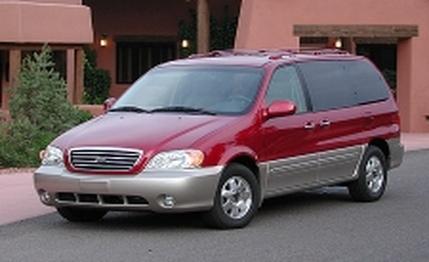 Road Test
Road Test
The greatest innovation this newcomer brings to the waning minivan party is its window sticker, which includes an invisible rebate of about $5000. That rebate has nothing to do with cash-back offers and zero-percent financing. What a concept! Charge what the car's worth in the first place. And it seems to be working. Last November and December, the Kia Sedona outsold the similarly sized Mazda MPV, Nissan Quest, and Mercury Villager, without incentives.
Feature content is Kia's incentive program. Our top-of-the-line Sedona EX model boasts four leather captain's chairs ($850), a 24-valve, 3.5-liter V-6, a five-speed automatic transmission, anti-lock brakes ($595), a glass sunroof ($575), and more power buttons than an Osterizer has. Heated windshield-wiper rests? Got 'em. Power rear vent windows with switches in the third row? Yep. And the price? Just $23,805 as shown - an average of $5000 less than similarly equipped rivals. The el cheapo LX model starts at just $19,590 and comes standard with the same drivetrain, front and rear air conditioning, power windows and locks, and cruise control.
What impresses us even more than the features-per-dollar density is the astute feel of the controls. The steering has a natural heft, with no on-center vagueness, no kickback, and good buildup of effort in turns. Brake-pedal force is similarly intuitive, with little dead travel and a reassuring feel as retardation builds (braking performance is also decent at 192 feet from 70 mph). Kia hasn't overtaken Chrysler for carlike driving dynamics yet, but it's looming in the Voyager/Caravan's rearview mirror.
If the Kia scores As in pricing and control feel, it earns Bs and Cs in most other areas. As minivan interiors go, this one is functional, offering loads of stowage nooks and bins, but the seats, although roomy and comfortable, do none of the tricks we've come to expect. The rear bench doesn't fold into the floor, none of the seats rolls on rails or wheels; they just become heavy and awkward cargo when they're not being used as seats. Neither the sliding side doors nor the rear hatch is motorized. And the overall packaging is unimpressive.
Outside, the Kia is sized between the short and long minivans from GM and Chrysler, but the usable space inside is nearly equal to that in the smaller, easier-to-park short-wheelbase domestic vans. The junior Chevy Venture, for example, offers the same 150 cubic feet of passenger space, but with the seats out, it holds five more cubes of cargo than the Kia, despite being smaller by 7.2 inches in length, 2.6 inches in width, and 1.9 inches in height. That suggests flab on the Sedona's part.
Similarly, the Sedona's body structure seems quite solid - impacts are absorbed without gut-jiggling repercussions. But Kia must be low on the CAD/CAM learning curve, as this rigidity appears to have been achieved by welding on extra iron. Massive six-inch-tall frame rails run the length of the floorboards, and they're five inches wide toward the front. Most other minivans we've measured use much smaller rails.
Holding that big body up requires strong suspenders, but welding iron suspension arms is cheaper and easier than casting alloy ones, so that's the Kia way. Not surprisingly, those hefty bits clomp over bumps and chuckholes like Monsieur Piedlourd. The five-link live-axle rear suspension is similar in design to those underpinning full-size SUVs, but without the driveshaft. And why not? Our Kia's 4862-pound curb weight is about the same as a Chevy Tahoe's. That's 200 pounds more than Chrysler's heaviest Town & Country Limited with all-wheel drive. Because the empty Kia Sedona weighs so much, the maximum payload it can carry is light - 1033 pounds for our loaded van. That's six 172-pound adults and no stuff.
Clearly, the DOHC 24-valve, 3.5-liter V-6 has its work cut out, but as minivans go, the Sedona accelerates quickly - 9.6 seconds to 60 mph. Our long-term Honda Odyssey did the job in 9.4, but most vans are slower. (Add seconds in the wet - traction control is not offered and the front tires spin eagerly.) Power delivery is smooth, and the engine sounds eager, although it is reluctant to start - the amount of cranking required will remind older drivers of the carbureted era. So will the gas mileage: 15 mpg city, 20 mpg highway by the EPA's reckoning. The five-speed transmission shifts smoothly, but the shifter limits manual selection to D-3-L.
Weight truly becomes the enemy when changing directions. With a below-minivan-average 0.70 g of grip available, we found ourselves arcing wide in turns at modest speeds, especially in the damp. But then, minivans aren't about cornering, right? They're about hauling paneling out to suburbia and taking the kids on vacation, and the Sedona can do both reasonably well. Of course, the paneling will need to ride atop the folded seats hanging out the open hatch, and the kids will have to make their own fun, as Kia does not yet offer a rear-seat video entertainment system.
Our bottom-line assessment? If you crave the latest in automotive fashion or technology and feel the need to swap cars every three or four years, then go for the cash-back deals most of the Japanese and American minivan purveyors are offering. Strong resale value makes those better vans a better deal over the shorter run. But if you're willing to drive the Kia for the duration of its 10-year/100,000-mile powertrain warranty, then send your first-born off to college in it and sell what's left to the plumber for $500, you'll have truly saved that $5000 and gotten your money's worth.